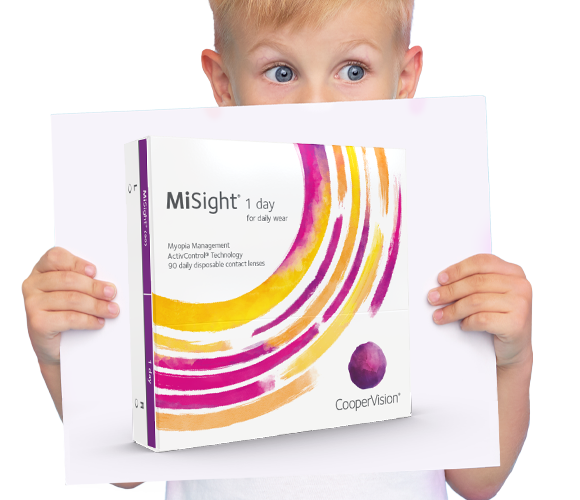
Real stories from real kids whose lives changed with MiSight® 1 day. See what clear vision1 can unlock

For active kids and growing teens, contact lenses can mean comfort, confidence and freedom.2
MiSight® 1 day contact lenses are indicated by Health Canada and are the first and ONLY soft contact lenses that are FDA approved* to slow the progression of Myopia in children aged 8-12 at the initiation of treatment.1†
Over a 3-year period, slowed myopia progression 59%, on average, reduced eye lengthening by 52% on average,1†§ and 41% of eyes had no progression. 1†¶ Over a 6-year period, children wearing MiSight® 1 day progressed less than 1.00D on average.3
90% of parents whose children wore MiSight® 1 day contact lenses reported that their children were happy wearing MiSight® 1 day lenses.4|
After using MiSight® 1 day contact lenses for three years, 90% of children still strongly preferred them over their glasses.5


Contact lenses offer continuous care and everyday convenience that glasses simply can’t match.2
Lenses stay in place all day, delivering consistent myopia control.±6
Unlike glasses, there’s no risk of forgetting or removing them.≠7
Perfect for sports, play, and busy routines.2
No frames in the way, just clear, consistent sight.✝1
Helps kids feel free and capable throughout the day.2
Ready to see how MiSight® 1 day contact lenses are changing lives? Watch as kids describe how these lenses are helping them reach a brighter tomorrow.

Myopia has been linked to two factors: genetics and family history,8 as well as a modern lifestyle with insufficient time spent outdoors, poor lighting levels, and prolonged time spent on digital devices.9-11

Indications and Important Safety Information. Rx only. Results may vary.
ATTENTION: Reference the Patient Information Booklet for a complete listing of Indications and Important Safety Information. This product may not be right for you, talk to your Eye Care Professional. *USA Indication: MiSight 1 Day (omafilcon A) Soft (Hydrophilic) Contact Lenses for Daily Wear are indicated for the correction of nearsightedness and for slowing the progression of nearsightedness in children with non-diseased eyes, who at the initiation of treatment are 8-12 years of age and have a refraction of -0.75 to -4.00 diopters (spherical equivalent) with ≤ 0.75 diopters of astigmatism. Canadian Indication: MiSight (omafilcon A) Soft Contact Lenses for Myopia Control are indicated for the correction of ametropia (myopia and hyperopia) in aphakic and non-aphakic persons with non-diseased eyes in powers from -20.00D to +2.00 diopters. The lenses may be worn by persons who exhibit astigmatism of -2.00 diopters or less that does not interfere with visual acuity. MiSight (omafilcon A) Soft Contact Lenses for Myopia Control may reduce the rate of myopia progression in children (6-18) and correct ametropia. Reduction of myopia progression was observed in children with wearing time of 12 hours (8-16 hours) per day, 6.4 days (5-7) per week in a clinical study. Permanent myopia control after lens treatment is discontinued is not supported by clinical studies. MiSight (omafilcon A) Soft Contact Lenses for Myopia Control are indicated for single use daily disposable wear. When prescribed for daily disposable wear, the lens is to be discarded after each removal. WARNINGS: Problems with contact lenses could result in serious injury to the eye. Do not expose contact lenses to water while wearing them. Under certain circumstances MiSight® lenses optical design can cause reduced image contrast/ghosting/halo/glare in some patients that may cause difficulties with certain visually-demanding tasks. PRECAUTIONS: Daily wear single use only. Patient should always dispose when lenses are removed. No overnight wear. Patients should exercise extra care if performing potentially hazardous activities. ADVERSE EVENTS: Including but not limited to infection/inflammation/ulceration/abrasion of the cornea, other parts of the eye or eyelids. Some of these adverse reactions can cause permanent or temporary loss of vision. If you notice any of the stated in your child, immediately have your child remove the lenses and contact your eye care professional.
† Compared to a single vision 1 day lens over a 3 year period.
§ Children aged 8-12 at the initiation of treatment.
¶ No clinically meaningful change in refractive error -0.25D or less from baseline.
| Overall experience as defined as children’s comfort, vision, lens handling, and freedom from spectacles. Children aged 8-15 years.
± In clinical study, mean weekday wear time increased from 12.8 hours/day at 6-months to 13.9 hours/day at 6-years with a mean of >6.5 days/week.
≠ Compliance with spectacle use in children is highly variable; broken spectacles, loss, forgetfulness, parental and children’s perceptions, peer pressure, and the patient’s self-esteem are a few reasons cited for poor compliance.
References